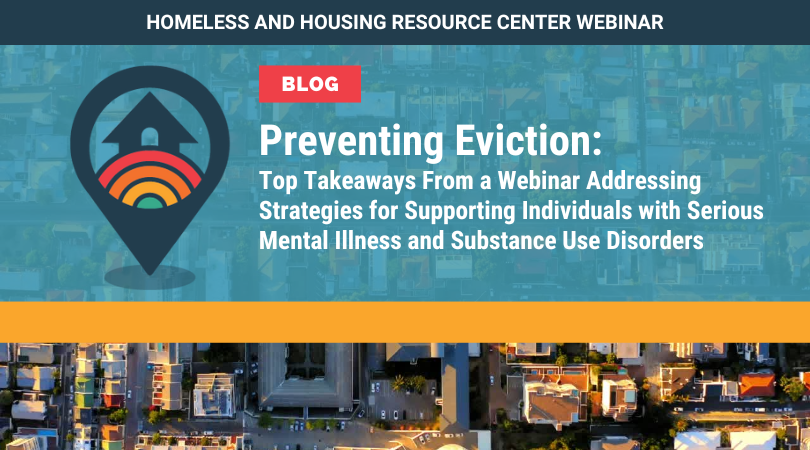Eviction can have profound consequences for anyone, but it can be especially disruptive for individuals with serious mental illness and substance use disorders, potentially exacerbating their health challenges and making recovery even more difficult. Effective eviction prevention strategies are essential for promoting housing stability, improving overall well-being, and reducing homelessness among this vulnerable population. SAMHSA’s Homeless and Housing Resource Center (HHRC) hosted a webinar titled “Eviction Prevention: Strategies for Supporting Individuals with Serious Mental Illness and Substance Use Disorders.” This event highlighted innovative eviction prevention strategies designed to improve housing stability—read on for background info and specific examples.
Q: Why is eviction prevention so critical for individuals with behavioral health conditions?
A: Eviction is a traumatic event that can significantly complicate a person’s ability to access housing and avoid homelessness. For individuals with serious mental illness and substance use disorders, eviction can exacerbate physical and behavioral health issues and hinder recovery opportunities. Preventing eviction helps maintain stability and supports the overall well-being of these individuals.
Q: What are some key competencies for effective eviction prevention?
A: Effective eviction prevention requires numerous competencies. Supportive approaches to eviction prevention efforts include the following:
- Incorporating trauma-informed responses
- Adopting Housing First approaches
- Centering equity
- Focusing on recovery
- Emphasizing harm reduction
- Implementing person-centered approaches
These knowledge bases and practices ensure that interventions are compassionate, inclusive, and tailored to individual needs.
Q: What are some innovative strategies for preventing eviction?
A: The webinar highlighted various innovative strategies for supportive housing providers, including the following:
- Integrating high-quality supportive housing services, such as Assertive Community Treatment (ACT) and supported employment
- Engaging and building trust with landlords by being responsive and checking in with them regularly
- Providing targeted support for tenants struggling with rent payments through budgeting assistance and landlord mitigation funds
- Offering mediation and assessment for tenants exhibiting challenging behaviors
Q: Can you provide an example of a successful eviction prevention case?
A: One case study presented during the webinar involved Ken, a 43-year-old man with schizophrenia and HIV/AIDS, who has been living unsheltered for 20 years. With strong relationships with his psychiatric prescriber and street outreach team, Ken expressed willingness to accept supportive housing if he could maintain these connections. This case underscores the importance of personalized and consistent support.
Q: How can service providers identify and engage households at the greatest risk of eviction?
A: Service providers should prioritize identifying and engaging households with members who have behavioral health conditions, low-income renters, Black/African-American households, and those with minor children. Engage these households with proven interventions, such as long-term rental assistance, one-time or short-term financial assistance, culturally responsive support, and high-quality supportive housing services.
Q: How can supportive housing providers and tenants navigate the legalities of eviction?
A: State and local laws, local court regulations, and the language in each specific lease determine the rules of eviction. The Eviction Laws Database can help providers and tenants explore their communities’ legal eviction process. Supportive housing providers may want to partner with a landlord-tenant attorney who can be available as needed. Free or low-cost legal assistance significantly increases tenants’ chances of favorable outcomes in eviction cases.
Q: What are some common barriers tenants face in eviction proceedings, and how can they be addressed?
A: Common barriers include confusion about court proceedings, lack of childcare, disabilities, transportation issues, and time off work. Many barriers can be address by providing clear information and accessible legal and support services, such as transportation assistance.
Q: What additional resources does HHRC offer to support eviction prevention efforts?
A: HHRC provides a variety of resources, including Eviction Prevention: A Toolkit for Tenants and Service Providers. It also offers online courses on serious mental illness, hoarding disorder, and opioid use disorder, among others, as well as written resources on fair housing protections and property management engagement strategies. Archived webinars and toolkits are also available to support service providers in their eviction prevention efforts.
For more in-depth insights and practical strategies, watch the full webinar below.


